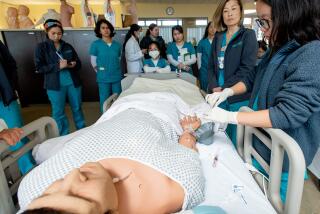CSU Report Calls for Full, 4-Year Campus in San Marcos
California State University officials say they want a full, four-year university, the system’s 20th, in San Marcos, perhaps by the year 1995, dramatically accelerating plans for what previously was to have been only a satellite campus of San Diego State University.
The staff conclusion is contained in a study by the chancellor’s office in Long Beach. The study was conducted in response to a demand by the Joint Legislative Budget Committee that the CSU Board of Trustees justify the need for all 300 acres for a San Marcos campus, on which the state closed escrow several months ago.
The study will be presented to the trustees for endorsement when they meet next Wednesday, then be forwarded to Sacramento for review.
The 300-acre site, a one-time chicken ranch along the south side of California 78 in North County, was selected in 1986 to serve as a satellite SDSU campus, with upper-division and graduate courses to begin in the fall of 1992. SDSU now provides upper-division and graduate courses for about 1,500 students in leased offices in San Marcos, and the selection of a permanent site was hailed as a significant step in meeting the higher-education needs of North County’s booming population and in saving students a drive of 30 or more miles to the San Diego campus.
There has been open speculation all along that the campus would one day evolve into a four-year school with a full palette of offerings for lower- and upper-division and graduate students; it was simply a question of when the decision would be made.
The yearlong CSU study of North County’s growth is the first official proclamation by state officials that the 300-acre San Marcos site is needed to house a full-service public university--the first in North County. Furthermore, the report is the first to propose a 1995 start-up for a full-service campus.
Officials say the campus will eventually be known as Cal State San Marcos. But they cautioned that the study, although justifying the need for all 300 acres to house a new campus, does not in itself constitute a formal funding request for a four-year university in San Marcos. That budget request will come in subsequent years, they said.
25,000 Students by Year 2020
“It’s one thing to assume (the campus would evolve into a four-year university); it’s another thing for a full public board to take that position. It’s a big deal,” said SDSU President Thomas Day. “They (trustees) are now ready to officially say, ‘This is it.’ ”
The campus can expect to have at least 5,000 full-time equivalent, or FTE, students by the year 2000, and 15,000 to 20,000 FTE--or upward of 20,000 to 25,000 individual students--by 2020, the feasibility study shows.
If approved as expected by trustees next week, the study will be forwarded to the California Postsecondary Education Commission and the Joint Legislative Budget Committee.
Bill Storey, assistant director for finance and facilities for CPEC, said it comes as little surprise that the CSU system is planning its 20th university, the first to be built since the mid-1960s, when Cal State Bakersfield opened.
Storey said the commission, which must bless the construction of post-secondary schools in California, will look kindly on a San Marcos campus.
“We can read the numbers as well as anybody else. Over the next 30 years, another million people will move to the North County area. That looks like a campus to me,” he said.
Community College Backing
Anthony Moye, deputy vice chancellor for academic affairs for the CSU system, said the proposed four-year university has already won the endorsement of two North County community colleges--Palomar in San Marcos and MiraCosta in Oceanside--as well as of officials from UC San Diego, UC Riverside and UC Irvine.
“San Diego State University is already over its peak capacity, and we’ve got to find a place to take the pressure off SDSU,” Moye said. “The North County campus will do that. North County students have no place else to go. This is the area with the largest pressure and no solution to the problem of where these kids will go to school.”
Moye said it is too early to figure the cost of a full-fledged campus. Already, $50 million is earmarked for the campus to open in 1992 for upper-division and graduate studies for 2,100 FTE students.
Much of the development of the campus, even the immediate development of the satellite campus, hinges on the success of a bond issue on the November ballot that would approve $600 million for state higher-education needs, Moye said.
The feasibility study notes that, although substantial population growth is expected in all of the state’s metropolitan areas, San Diego is home to the only state university without the ability to expand. Much of the demand for SDSU enrollment comes from North County, the study found.
A San Marcos campus “is fully justified within the mission of the CSU to provide instruction through the bachelor’s and master’s degrees,” the study says. “It would serve a large and growing regional population, the bulk of whom, for reasons of family and work commitments, would not otherwise have such an opportunity.”
Took a Closer Look
The study recommends that, eventually, as many as 30 bachelor’s degree programs and 12 graduate programs be offered at San Marcos, as well as teaching-credential programs and a general education program.
“Sure, everyone thought we would” declare San Marcos a four-year campus, said Moye. “But, when we originally contracted to purchase the land, the Legislature raised the question, ‘Do you really need this much land? You’d better take one more close look.’
“That’s what we’ve done. Otherwise, we’d be under some pressure to sell some of the land back, and then we’d never ever get a chance to grow,” Moye said.
He said legislators would be reluctant to eventually allocate funds for a four-year university if the system couldn’t justify the need for another campus.
“The state needs substantial evidence. We’ve done a very careful population survey, not only of the county but, in looking at where else North County students could go, and there are no other places. Building a new campus is the best solution to providing higher-education services.
“We all assumed it would happen sooner or later, but the data now is very solid,” Moye said. “This is the last major hurdle . . . so we can accelerate our planning process and make these facilities available.”
The campus’ enrollment would grow as a function of new classrooms being built as well as the university’s ability to develop its own reputation, he said. Growth in the early years would be relatively slow, but would increase dramatically at the turn of the century.
Careful curriculum coordination with Palomar and MiraCosta can help ensure that those two-year colleges will not be hurt, Moye said.
Carol Cox, an administrative assistant to state Sen. William Craven (R-Oceanside) and a member of a citizens advisory committee to the chancellor’s office, said she is “extremely happy” with the study’s findings.
“The senator always wanted this to be a full, four-year campus, with the growth taking place in North County,” she said. “In that regard, we’ve been working behind the scenes for a long time for this to happen. This is wonderful.”
More to Read
Sign up for Essential California
The most important California stories and recommendations in your inbox every morning.
You may occasionally receive promotional content from the Los Angeles Times.










